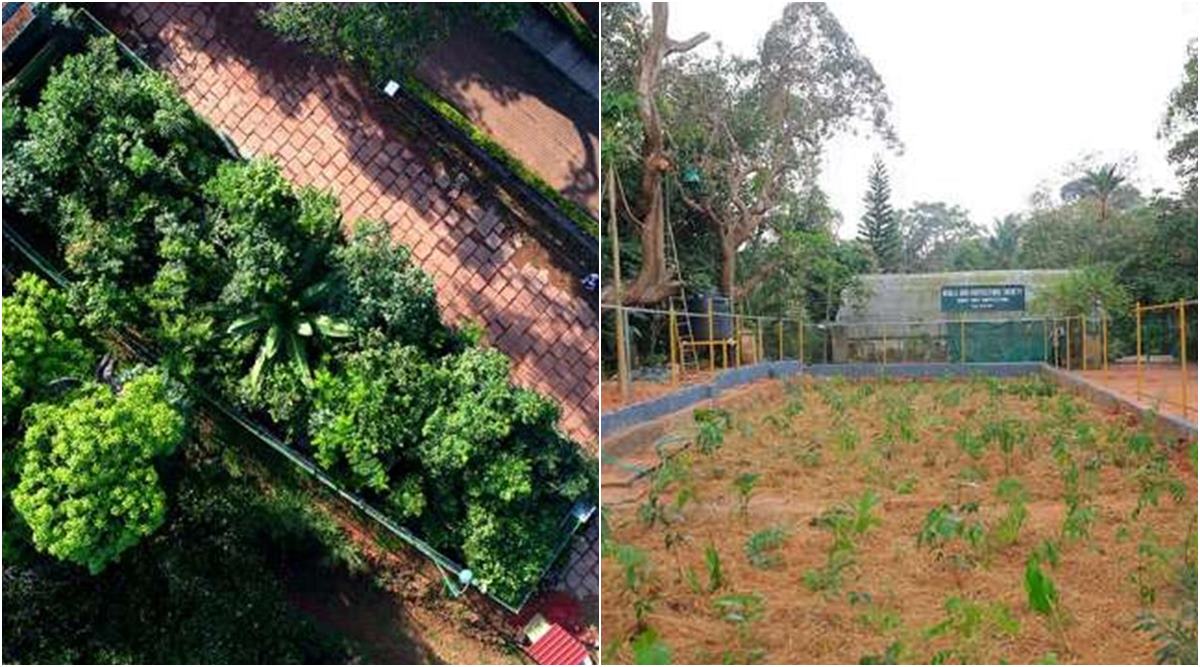 The patch of land at Kanakakunnu, before and after the Miyawaki afforestation project. (Credit: Crowd Foresting)
The patch of land at Kanakakunnu, before and after the Miyawaki afforestation project. (Credit: Crowd Foresting)In January 2019, a section of the grounds of the beautiful Kanakakunnu Palace built by the erstwhile Travancore rulers in the heart of Thiruvananthapuram was taken up for a unique afforestation project. Known worldwide as the Miyawaki model, named after 92-year-old Japanese botanist Akira Miyawaki, it involves raising a dense mini-forest on a small parcel of land using only indigenous species. Experts say compared to a normal forest taking about 100 years to grow on its own, the Miyawaki model can help build man-made forests with the same density in just about one-fifth of the period.
On the grounds at Kanakakunnu, nearly two years later, the success of the pilot project is for everyone to see. In a city whose urban spaces are crying for green cover, the patch of land has flourished with tall, closely-packed trees of the likes of mango, jackfruit, banyan and medicinal herbs like heart-leaved moonseed.
“Within just 12 months, we were able to see the biodiversity that we created on a five-cent land. For example, after the forest came up, we spotted many rare birds that hadn’t been seen in the area for a long time. Also, a lot of insects and worms,” said Hari Prabhakaran, who’s the founder-director of the Nature’s Green Guardian Foundation, an NGO that was part of the project at Kanakakunnu.
The successful experiment, one of the earliest in Kerala, has propelled the state’s tourism department to raise similar micro-forests on the Miyawaki model at 22 tourism spots across 12 districts. The project, being implemented at a cost of Rs 5.75 crores, is aimed at turning tourist spots into eco-friendly spaces and spelling out the benefits of such afforestation programmes to the public. Many of these spots are also predominantly located in urban locales.
As per a government order, some of these tourist spots include the Shankhumukham beach in Thiruvananthapuram, Thottappilly park in Alappuzha, Munambam beach in Ernakulam, Kanjirapuzha dam garden in Palakkad, Kappad beach and Sarovaram bio-park in Kozhikode. Prabhakaran’s Nature’s Green Guardian Foundation is the technical consultant of the project.
“Environment protection has been an important aspect of our Responsible Tourism initiative,” said Vijayakumar, the Ernakulam district secretary of the tourism department.
“This is a model project which is informative as well as delightful to public and the tourists. We are bringing an ambience of a forest to our tourist spots. The people can also take inspiration from it and replicate it in their own private land,” he added.
The key to the Miyawaki model, Prabhakaran explained, is the incubator-like bed of fertilisers prepared with utmost care that will provide the trees with the essential nutrients for the initial three years.
“We choose species that are indigenous and local to that area and plant them closely. With the help of nutrients from the fertiliser bed, they grow into mature trees within three years. By then, their roots would have become strong and would go beyond the fertiliser bed. All trees are grown at the same level in the same time period,” he said.
“Just like a plant grown in a balcony which extends towards the sunlight as part of a natural instinct, here too, all trees will be fighting to get sunlight. In that struggle for existence, they will grow fast into a tightly-packed jungle.”
The Miyawaki model, he stressed, will be a better success story in the hands of the government than a private individual or a firm because of the returns of the investment.
“Because we need to pre-load fertilisers into this incubator nutrient bed for the first three years, the investment here is more than the average investment a private entrepreneur/company would push for a monocrop plantation. A private individual will look for returns which are not visible. However, he can feel it and the benefits of such a micro-forest can be felt in his life and around his home,” he said.
The Japanese model, that reportedly promises a 30-times better carbon dioxide absorption compared to traditional plantations, has spawned micro-forests in large urban metropolises like Mumbai and Paris.